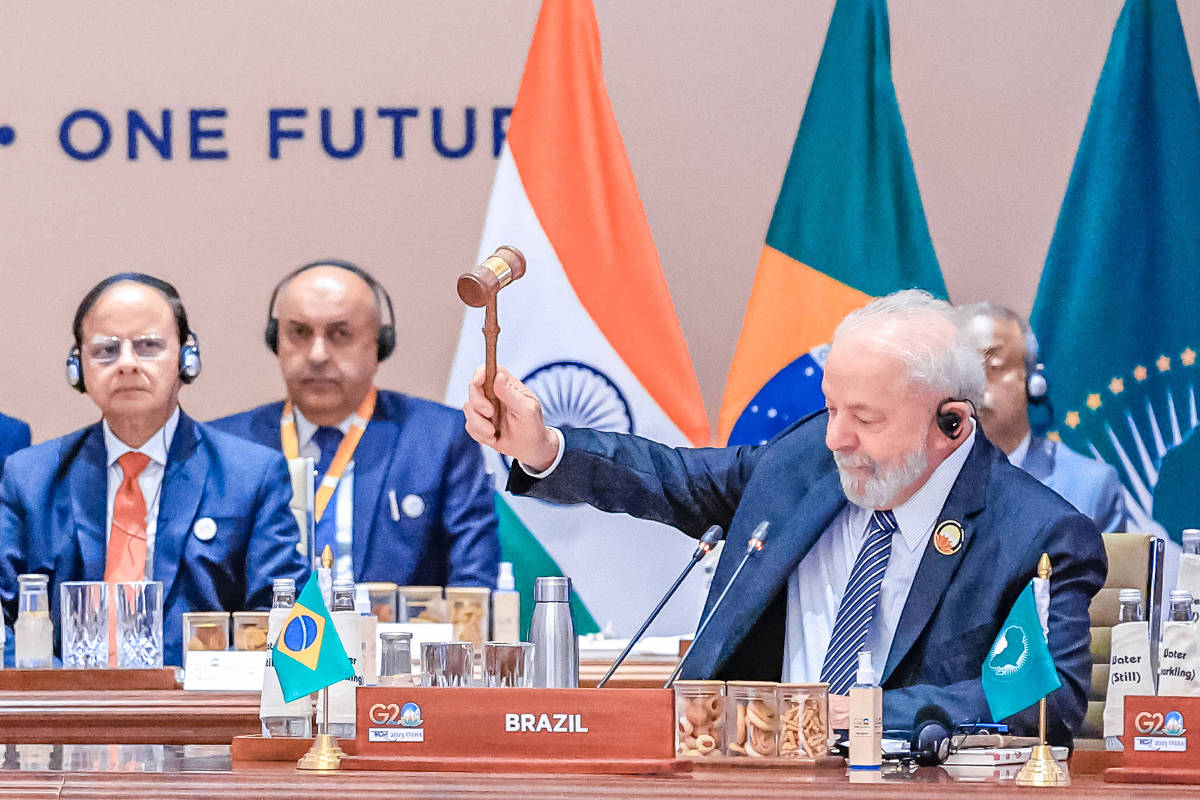Leia o artigo em português / Lea este artículo en español.
In December 2023, Brazil began presiding over the G20. The one-year presidency, which will culminate in the annual summit being hosted in Rio de Janeiro in November 2024, is the third of four terms led from the global South—following Indonesia in 2022 and India in 2023, and preceding the already decided South African presidency in 2025. When India’s Narendra Modi formally handed over the presidency to Brazil last November, Lula announced three priorities to “place the reduction of inequalities at the center of the international agenda: (i) social inclusion and the fight against hunger (ii) energy transition and sustainable development in its three aspects (social, economic and environmental) and (iii) reform of global governance institutions.” The proposals were well received internationally. From now until the November summit, the task is building concrete proposals and agreements that can fulfill these aims.
Though the Brazilian government’s proposals are progressive, the G20’s multilateral dialogue continues within the context of international institutions that long predate it—reflecting the balance of global economic power in the middle of the twentieth century. Forged after World War II, institutions such as the International Monetary Fund and the World Bank now undergird an international governance system that does not represent the tremendous changes that have occurred in the world economy since the 1970s. Dominated by countries whose economies represent a shrinking share of world production and trade, these institutions reproduce asymmetries of power over the subjects of multilateral diplomacy—which are today indispensable for mitigating global climate change and extending social protections over the world’s economically and socially vulnerable populations.
The increased weight of the global South among countries making up the G20 indicates a changing balance of forces within the group—and shows how the moment is conducive for a shift in strategy. The group’s last summit in New Delhi illustrated the enhanced importance of the global South. Under the Indian presidency, two major events marked a shift towards multipolarity: the absence of a unilateral position on the war in Ukraine and, more importantly, the inclusion of the African Union (AU) as a permanent member of the group.
Figure 1: Members of the G20 after the 2023 Summit
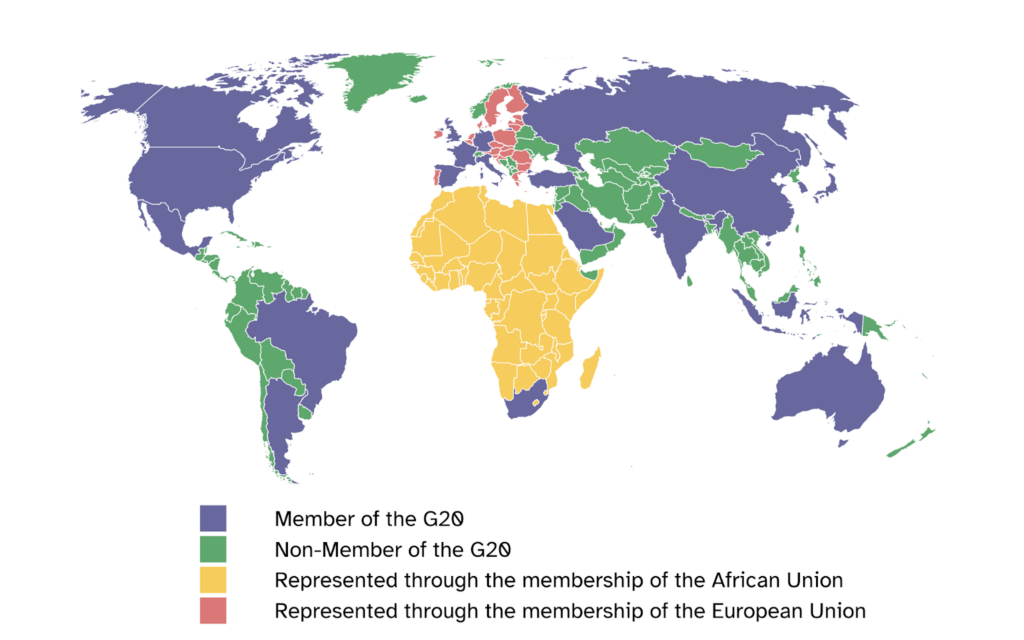
The increased weight and, consequently, the increased political power of the global South within the G20 favors a new global agenda for the twenty-first century. Assuming the rotating presidency for the first time, the Brazilian government has a great opportunity to promote coordination among middle-income countries to pursue common goals.
Though political diversity within the global South means a more formal diplomatic strategy for structuring an economic bloc might remain elusive, the Brazilian government’s listed priorities identify common interests that can strengthen joint action.
The global South at the G20
With the recent incorporation of the African Union, the G20 map has changed substantially, with a far greater share of the globe now represented in deliberations. Considering geopolitical—as well as geographic and economic—criteria, we distinguish the G20’s global North members as Germany, Australia, Canada, the United States of America, France, Italy, Japan, the United Kingdom, the Republic of Korea, and the European Union. Those of the global South are South Africa, Saudi Arabia, Argentina, Brazil, China, India, Indonesia, Mexico, Russia, Turkey and the African Union.
Grouping the G20’s member countries according to this division illustrates the changes of the last few decades. Shares of global GDP are a widely criterion for international economic analysis: since the beginning of the twenty-first century, there has been a rapid transformation in the weight of the two groups of countries. The latest data from 2022 show that we are living at the precise moment when the global South is overtaking the North.
Figure 2: Share in global GDP (in purchasing power parity)
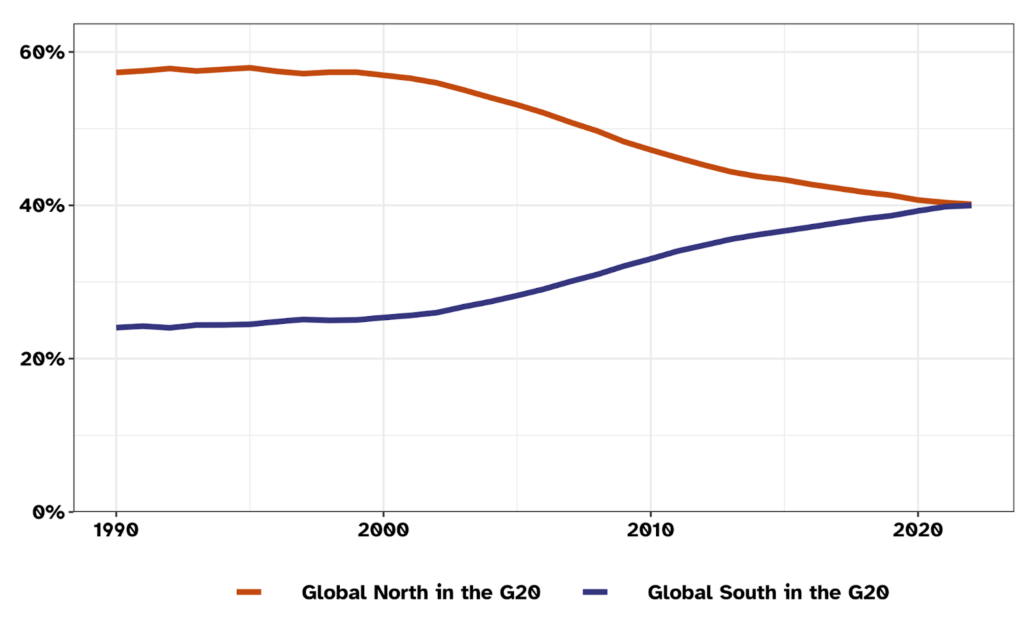
With the growth of the world economy between 1990 and 2022, the global North G7 countries’ combined share of world GDP fell by one fifth—from 57 percent to 37 percent (figure 3). The global South’s rising share of world GDP makes the G20, rather than the G7, a forum for global governance of undeniable importance.
Figure 3: G7 share of G20 GDP (in purchasing power parity)
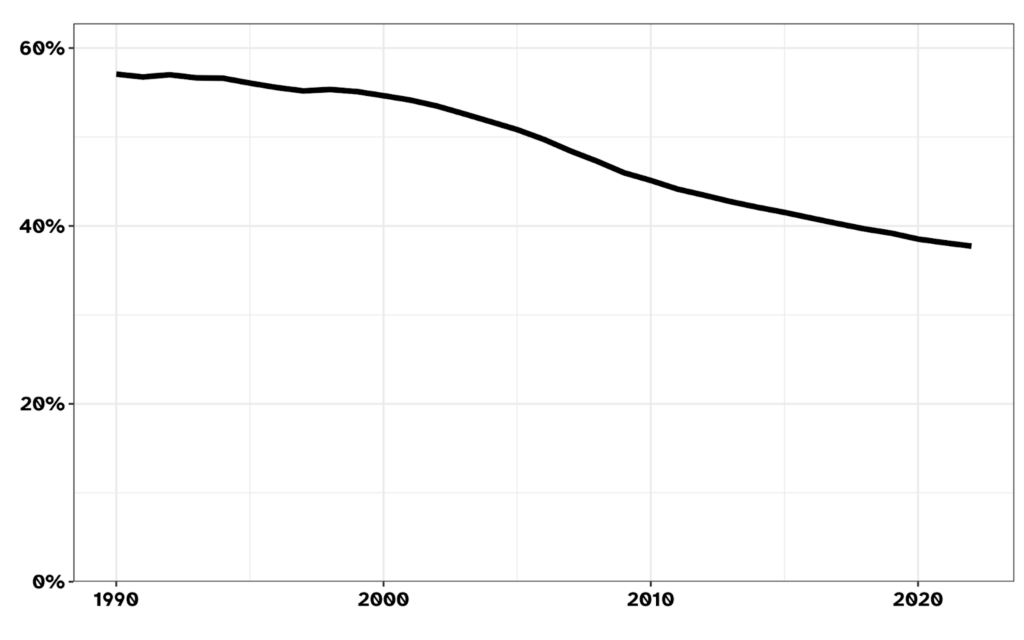
Although the Chinese economy significantly leads the global South’s upward trajectory, that alone does not suffice to explain it. By isolating the two largest economies on the planet (the USA and China), Figure 4 shows that the contribution of the other countries of the South to the real GDP growth of the G20 has, since the beginning of the twenty-first century, been almost invariably greater than that of the other countries from the North.
Figure 4: Contribution to G20 real GDP growth (%)
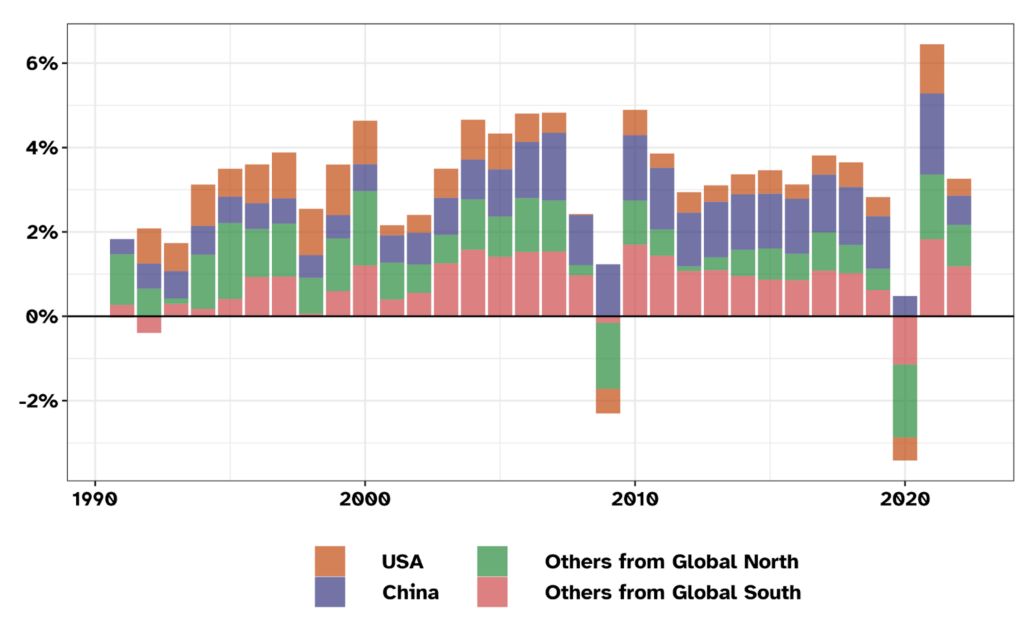
When we analyze industrial production, the transformation is also quite significant. Although there are substantial differences in the participation of each of the global South countries in global value chains, in aggregate quantitative terms the evolution of the group of countries is notable. At the time of the creation of the G20 in 1999, the participation of global South countries in the group’s total industrial production was around 10 percent. From 2005 onwards this share began to grow rapidly, reaching almost 50 percent in 2021 (figure 5). In the coming years, despite the “reshoring” movement promoted by the USA, the global South is likely to surpass the North, according to this criterion.
Figure 5: Industrial production (% value added in relation to the G20 total)
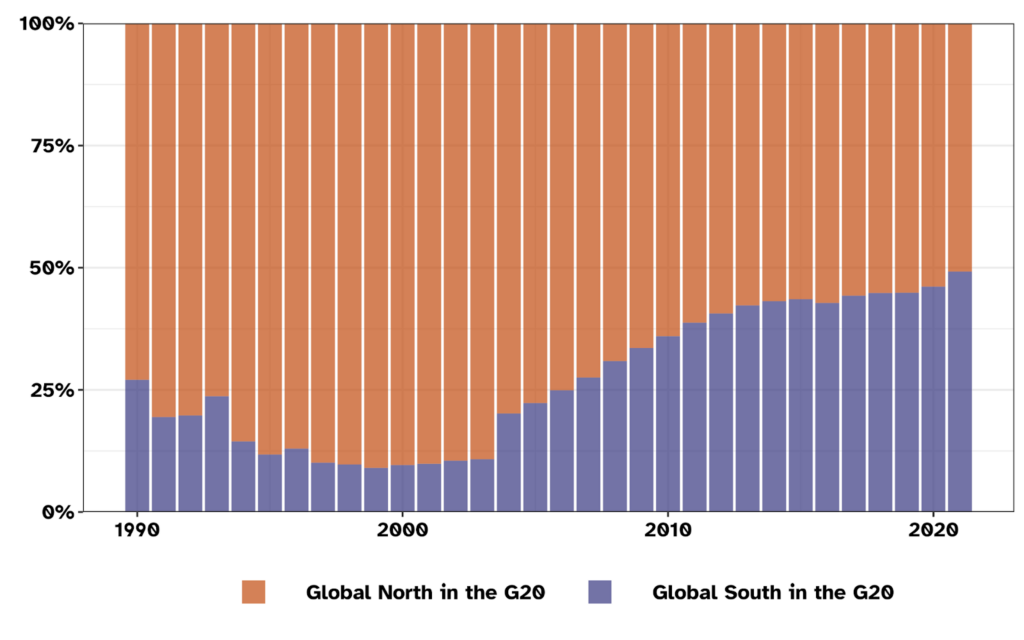
From the point of view of international trade, the participation of countries in the global South is also increasing. When the G20 was created, the South’s share of total exports was approximately 13 percent. In 2021 it was more than 30 percent (figure 6). The increase in exports reflects the growth in the production of industrial goods, as demonstrated above, but also the great relevance of global South countries in the production and export of agricultural and mineral goods. Figure 7 shows the importance of the South in the production of some of the most relevant foodstuffs for the diet of the majority of the world’s population. The global South has long been a leader in the production of rice (China and India) and sugarcane (Brazil, India, and China), but in the last three decades countries from the South also expanded production of other foodstuffs where production was traditionally concentrated in the North of the G20.
Wheat and meat production in the global South, for example, surpassed that of the North in the 1990s and currently represents around 60 percent of the total produced by the G20. The South began dominating soybean production at the beginning of the twenty-first century, with its current share around 60 percent (with emphasis on Brazil and Argentina). In corn production, the USA is still the most important single producer, but in our analysis, dividing participating countries into two blocs, the global South has become more relevant than the North (mainly due to Chinese and Brazilian production) even in corn.
Figure 6: Share of the global South in total G20 exports (%)
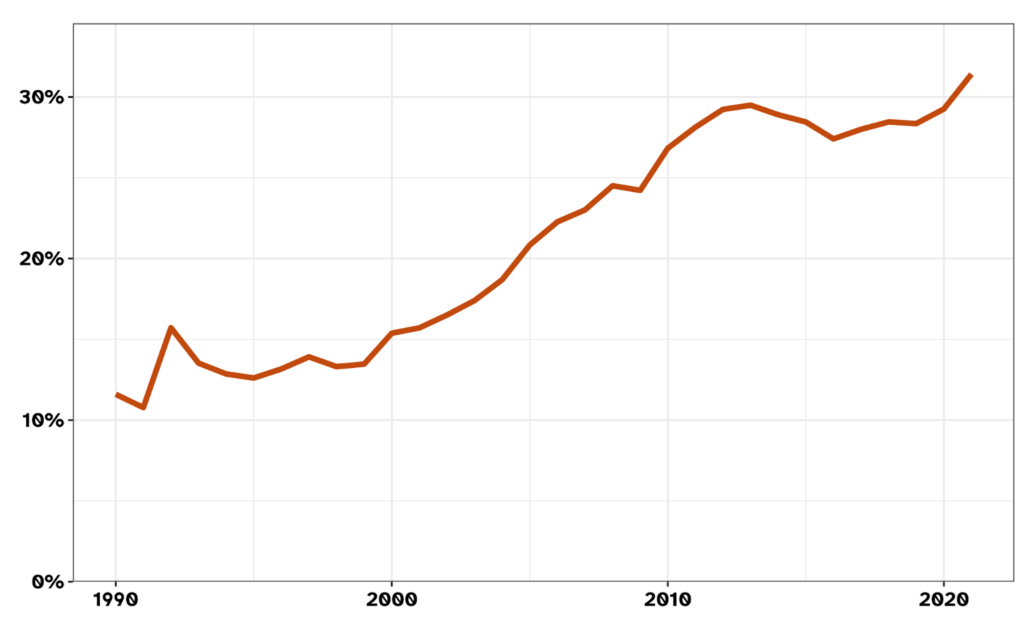
Figure 7: Food production, selected foodstuffs (% in relation to the G20 total)
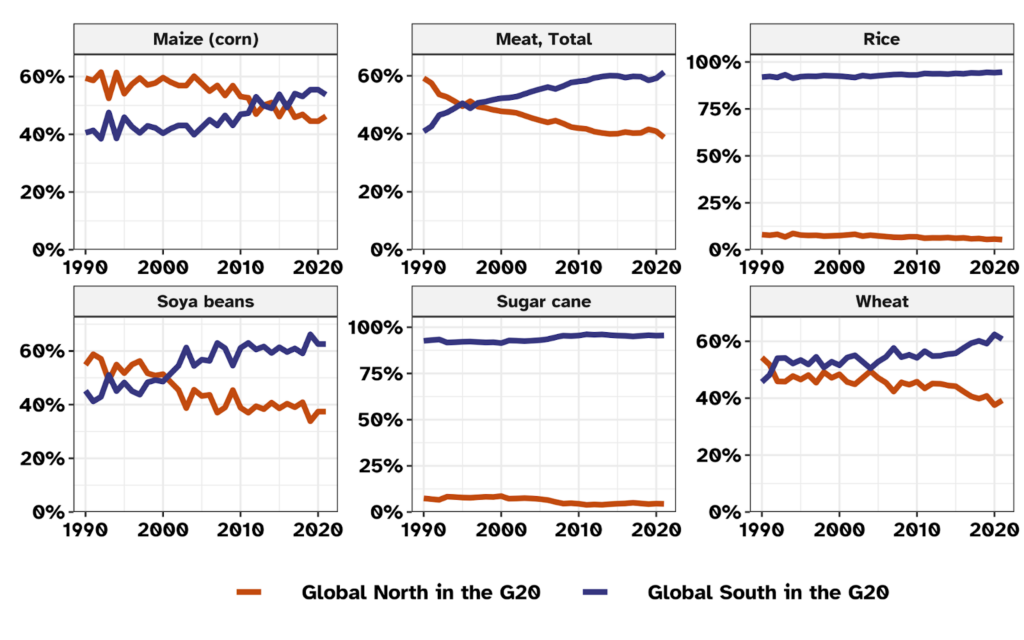
On the all-important question of electricity production among the G20, the countries of the global South already overtook the North in 2013, and currently exceed the latter’s production by more than 40 percent. Even more relevant than the quantity produced is the diversity of sources. Figure 8 shows that the global South has equivalent or greater production in sources considered clean (such as hydroelectric, wind, and solar energy), but that the volume of energy production through the burning of mineral coal is still extremely large—mainly due to China and India.
These data demonstrate the impossibility of thinking about the energy transition at the global level without the inclusion of the South. On the one hand, this underscores the importance of countries in the South committing to emissions reductions, and on the other, it calls for serious collaboration and commitment from the North to the South—including tech transfers and agreements that ensure the transition is made quickly and without reinforcing structural inequalities. There are also important heterogeneities among countries in the global South, making the energy transition more challenging for some than others. Within the scope of the G20, it is crucial, therefore, that the environmental agenda is formulated by taking into account the main drivers of increase (and potential reduction) in carbon emissions for each country.
Figure 8: Electricity production, by source, G20 (TWh)
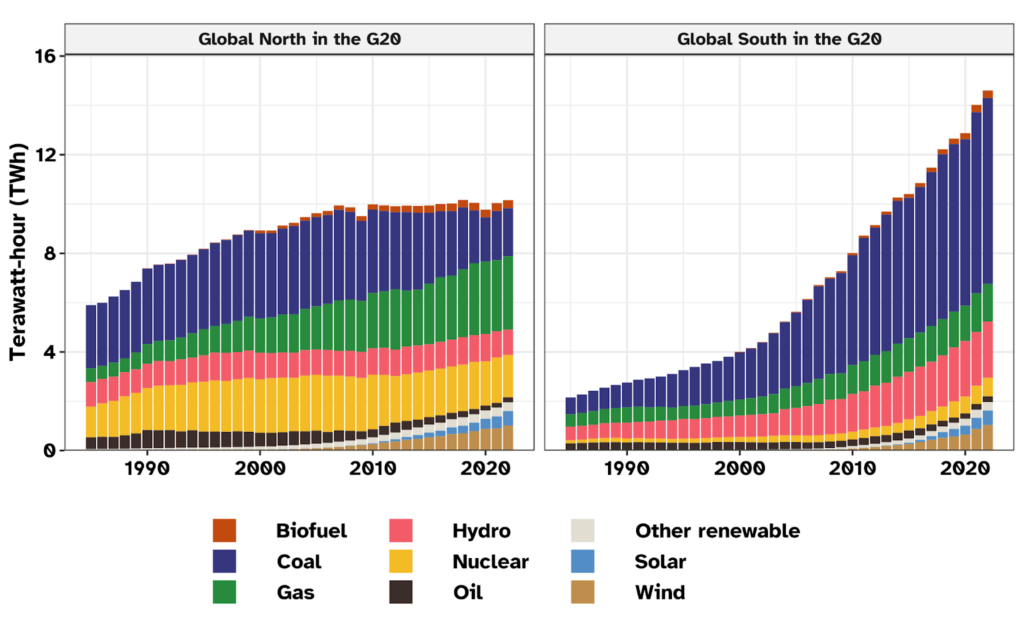
The flip side of the coin
The increased importance of the global South in the G20, revealed by economic metrics related to production and trade, is not reflected in the functioning of the international monetary and financial systems. For the international foreign exchange markets as a whole, the volume of transactions involving the US dollar represented 90 percent in 1989 and 88 percent in 2022.1
The dollar’s resilience contrasts with the loss of the US economy’s relative importance to world production. In the same period, the only currency issued by the global South that has seen a noteworthy rise is the Chinese renminbi, which has risen from 0 percent of transactions in 1989 to 7 percent in 2022. Considering that China’s GDP currently accounts for around 15 percent of global GDP (in purchasing power parity), this remains a huge discrepancy. Currencies from large economies in the global South, such as India (2 percent) and Brazil (1 percent), are absolutely marginal on the international scene.
This asymmetry in the international monetary and financial systems has major global macroeconomic impacts, generating what Valérie Giscard D’Estain in an earlier era of currency politics described as an “exorbitant privilege” for the country issuing the key currency and, for countries issuing peripheral currencies, what we have called a “compulsory burden,”2 as the marginality of their legal tender in world markets means they often face greater volatility in their exchange rates, higher interest rates on their borrowing, and consequently less autonomy in economic policy.3 Monetary asymmetry is also, of course, a source of geopolitical power. With nations dependent on dollar earnings in trade and financial markets, the US uses its currency—and the international monetary and financial systems based on it—as weapons of war.4
Alongside the hegemony of the US dollar, the main multilateral financial institutions maintain governance rules that verge on the anachronistic. The weight of the vote and veto power held by the USA in the IMF, for example, ignores the vast geopolitical and economic changes that have occurred in the world since 1945, and reinforces inequalities between countries. The creation of the Special Drawing Rights in the late 1960s, while a shift toward the recognition of an emerging post-World War II world, means little when control over the issuing institution remains so tightly held by the USA.
Beyond economy, people
Alongside the analysis of economic indicators, it is pertinent to look at the demographic data of the G20 member countries. The population portion of the global South was already vastly superior to that of the North by 2022, and the entry of the African Union into the group in 2023 made this picture even more unbalanced. Figure 9 shows that more than 80 percent of the G20 population (including the national federation members) is in the countries of the South. According to United Nations (UN) estimates, the populations of the global North and South outside the AU will remain relatively stable or will undergo modest growth over the next three decades, while the AU population is expected to increase by around one billion people, raising the demographic participation of the Global South in the G20 to around 86 percent of the total.
Figure 9: Total population, members of the G20 (billions of people)
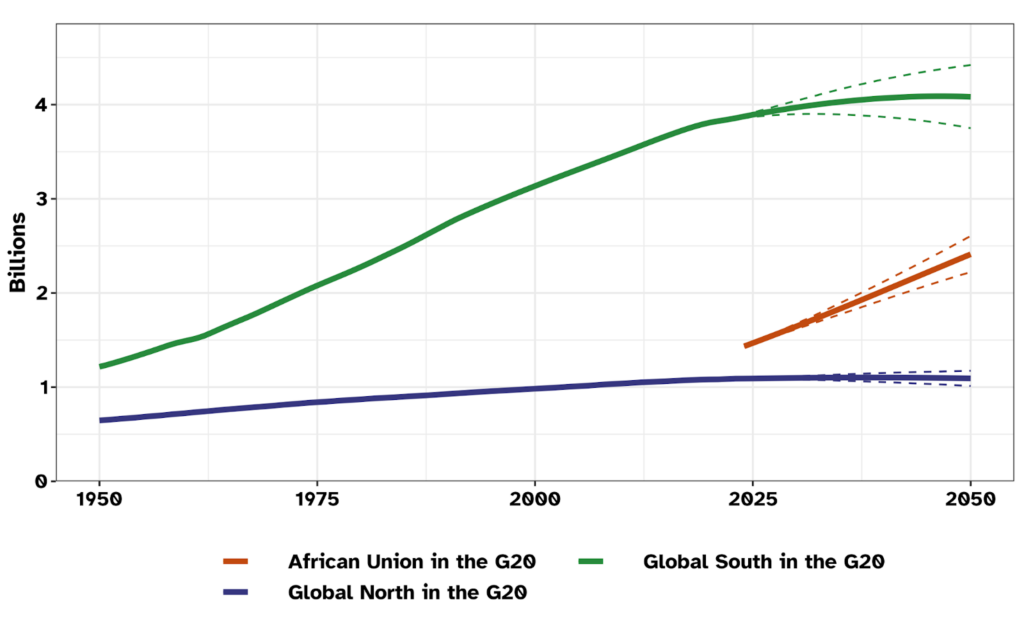
If we only consider the population under twenty years of age, the discrepancy is even greater. Figure 10 shows that, with the inclusion of the AU, the global South currently holds almost 90 percent of the young population of the G20—a situation that is likely to continue over the coming decades.
Figure 10: Population under 20 years old, G20 (billions of people)
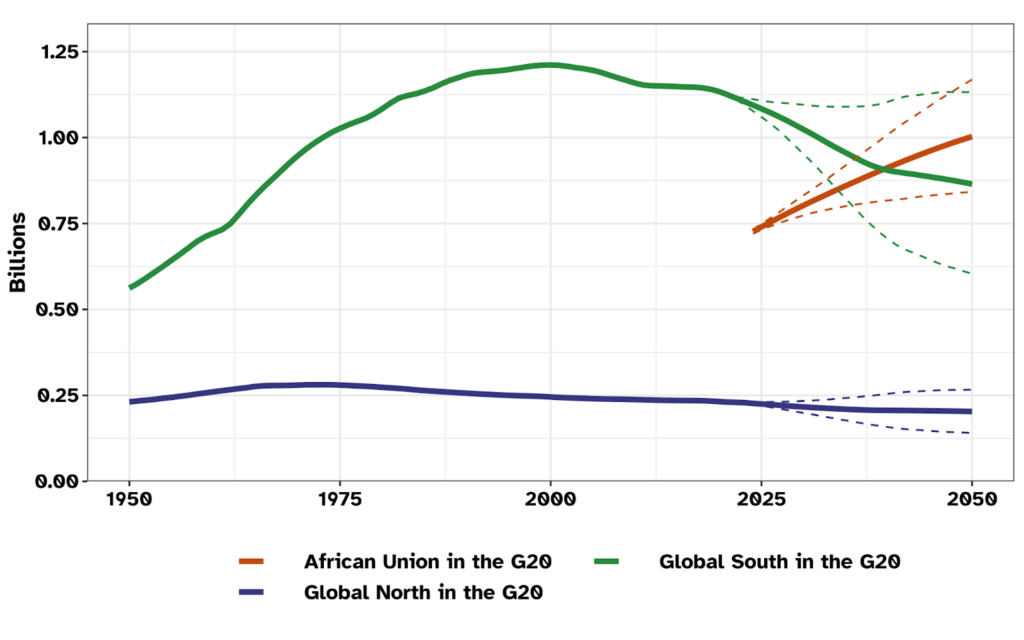
These economic and demographic metrics reveal the great and growing importance of countries from the global South in the G20. These trends have unquestionable geopolitical effects, indicating the increase in the power of the South and favoring its action as a bloc in the pursuit of common interests.
South-South agendas
The increase in weight and the consequent increase in the bargaining power of the global South in the G20 reveals that we are living in an opportune moment to press for a new structure of global governance that more concretely represents the economic and geopolitical transformations of recent decades. The global South’s effort to expand its voice in international arenas is not new, but the current situation allows the Brazilian presidency to leverage the demands of this group of countries.
An important factor is the exponential expansion of Chinese geopolitical power. If the countries of the global North do not give space to the other countries of the South, they will favor a continuing rapprochement with China. The expansion of BRICS to include six new countries (Saudi Arabia, Iran, Ethiopia, Egypt, Argentina, and the United Arab Emirates), beginning in 2023, for instance, may represent the growing importance of international coordination forums outside the G20.
Brazil’s domestic context also shapes this important moment in world politics. After six years as an international pariah among nations, Brazil is returning to its role representing the possibility of social democratic development on the world stage with the reelection of Luís Inácio Lula da Silva. In the first months of his third term, Lula repositioned himself as a key world leader, especially on issues related to peace, the fight against hunger, and the climate crisis. To pursue these goals in the world economy, it is important that the Brazilian G20 presidency vigorously defends proposals for debt relief or forgiveness for low-income countries—especially in a context of fiscal adjustment widely encouraged by the international monetary and financial systems.
The G20 has already demonstrated a capacity for such fiscal liberalism. In 2020, seeking to minimize the impacts of the pandemic and public debts on the growth trajectories of low-income countries, the G20 established the Debt Service Suspension Initiative (DSSI). From May 2020 to December 2021, the initiative suspended US$12.9 billion in debt service payments for participating countries,5 extending social spending to the socially vulnerable in a moment of global economic turmoil. The value, however, was just over a quarter of the total announced at launch.6 In 2022, the program was replaced by the Common Framework for Debt Treatment Beyond the DSSI, currently in effect. Both programs proved to be slow, exclusionary of middle-income countries, and unable to attract the full participation of creditors.7 There is room to move forward with a better and more comprehensive project to renegotiate or forgive debts for countries in the global South.
The issue of external debt and the consequent lack of fiscal space are linked to another crucial problem: the rising costs of climate financing. Over-indebted countries will need to increase spending on the green transition if the G20 is to achieve its common goals. The international community’s reluctance in proposing alternatives to the debt of low- and middle-income countries makes it impossible for countries most vulnerable to climate change to invest in mitigation and adaptation.8 The fact that the Brazilian government is today an international net creditor only increases the legitimacy of this claim.
The global politics of national fiscal rules reveal asymmetries in the international monetary and financial systems that the Brazilian G20 presidency can begin to address. The resistance of countries from the global North to reforms is still very strong, but the recognition of the dysfunctionalities of the current system legitimizes the demands of the South. Some changes will not come from deliberative multilateral bodies, but rather from dramatic and unpredictable economic and geopolitical transformations. Nevertheless, the multilateral institutions at Bretton Woods are important tools, and should be subjec tto dialogue and pressure at G20 meetings.
Additionally, the Brazilian initiative to create a Global Alliance Against Hunger and Poverty could have broad global repercussions—if it culminates in a concrete proposal that includes, above all, a financing structure and coordination between the various government bodies. With political will and an effective institutional design, it is possible to mitigate the sordid reality of almost 800 million people starving in a world that produces sufficient amounts of food to feed them. Such design can be based on success stories from the global South itself—like that of China, with its policy of targeted poverty alleviation, and that of Brazil, with its Zero Hunger Policy.
Finally, the issue of sustainability—in its economic, social, and environmental iterations—must be given priority, as it cross-cuts all of the questions of financing and coordination broached by Brazil’s G20 agenda. Financing the green transition, guaranteeing conditions for non-exploitation of preserved environmental areas, and the differentiated burden of carbon-emission reductions for countries in the global South and North are central.
Brazil here faces an impasse shared by other countries from the global South and North: a world in which the energy transition is taking place quite slowly presents continual economic opportunities for one of the world’s largest oil producers to continue oil exploration in areas such as the Equatorial Margin. It also offers new forms of geopolitical power (see the movement to join OPEC+). Amid the severity of the current environmental crisis, the current government should remain firm in defending effective environmental policies. Given the centrality of the green transition on the G20 agenda, and the fact that Brazil will also host COP30 in 2025, the moment is opportune to open channels of dialogue, partnerships, and financing to maintain these environmental commitments.
These are some examples of how the priority axes defined by the Brazilian presidency of the G20 can articulate the growing importance of the global South in the bloc and influence effective changes in the resolutions of the 2024 summit. There are no national solutions to global problems. The pandemic clearly demonstrated the failure of current global governance structures in coordinating collective solutions. The unseemly race to purchase vaccines, when rich countries guaranteed quantities of doses far exceeding their needs while most of the global South had not even guaranteed the first dose for their population, clearly illustrated the need for transformations.
Likewise, issues related to structural inequalities or the climate crisis will not be resolved if the wealthy countries persist in the same patterns of an evidently flawed system. If the G20 is unable to challenge these structures, there’s no point for it to survive as a relevant forum. For every ten young people in the G20, nine are in the global South. If the group’s agenda pays more attention to one young person from the global North than nine from the South, the forum will have failed. In this sense, Brazil’s presidency of the G20 can play a historic role in reorganizing global governance. To do so, it will have to be cautious in relation to the agendas imposed on it by traditional multilateral institutions, prioritizing the needs of the global South and favoring coordination between these countries, in order to act as a bloc in the defense of common interests.
This essay was translated from Portuguese for Phenomenal World by Georgia Kirilov.
BIS Triennial Central Bank Survey (for 1989 and 2022), https://www.bis.org/statistics/rpfx22.htm.
↩Ricardo Carneiro and Bruno De Conti, “Exorbitant privilege and compulsory duty: the two faces of the financialised IMS,” Cambridge Journal of Economics 46, no. 4(2022): 735–752.
↩Daniela Magalhães Prates, “Crises Financeiras dos Países ‘Emergentes’: Uma Interpretação Heterodoxa,” (tese de doutoramento, Universidade Estadual de Campinas, 2002).
↩Ernani Teixeira Torres Filho, “A bomba dólar: paz, moeda e coerção,” (Texto para discussão IE/UFRJ, n. 29, 2019).
↩World Bank, World Development Indicators (2023), https://datatopics.worldbank.org/world-development-indicators/.
↩Bretton Woods Project, “Ineffective G20 Debt Service Suspension Initiative ends as world faces worst debt crisis in decades,” April 6, 2022, https://www.brettonwoodsproject.org/2022/04/ineffective-debt-service-suspension-initiative-ends-as-world-faces-worst-debt-crisis-in-decades/.
↩Marina Zucker-Marques, Ulrich Volz, and Kevin P. Gallagher, Debt Relief By Multilateral Lenders. Why, How and How much? (Boston, London, Berlin: Boston University Global Development Policy Center; Centre for Sustainable Finance, SOAS, University of London; Heinrich-Böll-Stiftung, 2023).
↩Zucker-Marques, Volz, Gallagher, “The debt and climate crises are escalating—it is time to tackle both,” in Debt Relief By Multilateral Lenders.
↩
Filed Under
